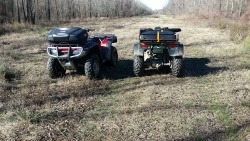
American management practices use a lot of techniques to examine planning, program development, future goals, and modes of execution to achieve those goals. One of the business school tactics used by many groups is called the SWOT.
This stands for (1) Strengths, (2) Weaknesses, (3) Opportunities, and (4) Threats. Walking through this process applied to your prepping plan can assure confidence of achievements, point out items for improvement, expose future opportunities and recognize potential threats. It is an assessment strategy to reveal all the functional aspects of your prepping plan and processing.
Remember that your SWOT is not my SWOT or Reuben’s down the street. There can be no two plans or executions just alike. Therefore, there really is no textbook SWOT to copy or plagiarize. It is a process that only you or your prep team can solely experience, define, construct, refine, and deploy. It has to be customized to your situations, conditions, and circumstances.
Strengths

What have you done right and what are you doing right? Do you have a basic plan advancing to a more thorough plan laid out, via paper, or PC or both? Is all this development work documented in a file, notebook, or folder for constant referral and reference? If not, this is the place to start.
Your personal prep manual needs to be easy to reach and within reach at all times. Then when an idea or lightbulb thought pops up, you can jot it down. Keep plenty of plain paper in the side pocket for such notes, then refine them to move to the main manual pages if appropriate. Prepping is a constant moving target, but the ideas need to be collected.
Review all your prepping components. You may have a “Bug In” section as well as a “Bug Out” section just in case options are a viability. Then break it down into all the categories of stuff that have been discussed here at Survival Cache and our Blog pages over time.
Confirm what items you have completed and what items need work. Review your supply lists, weapons cache, and every item in your prep plan so far. This is an emphasis on your plan’s strengths, but does not imply completion.
Weaknesses

This is not the time for dogging yourself or your plans. It is a time to constructively peel back the layers to see what is not working, at least not yet. On this examine it is time to reveal things you are not doing or have failed at completing. A good practical example is training achieved to date.
Can you put that tent up in the dark, even in the backyard? Do you know how to disassemble that AR you bought for Christmas? Have you finished calculating how much food and calories your family will need for an extended SHTF? Is your bug out camp ready to go? Do you need a course in auto or engine mechanics, welding, carpentry, or camp cooking?
Also examine what factors or elements are preventing you from moving weaknesses to strengths. Is a limited, tight, or reprioritized budget part of the issue? Are you setting any funding aside for prepping causes regardless of how little it is? Have you considered weekend employment or selling off some unnecessary items to raise funds for prepping? This is not easy.
Again, weaknesses are things that are probably on your prepping plan list but you simply have not followed through. If it is a critical element like securing proper quantities of food, water, ammo, medical supplies or whatever, then just dedicate yourself to chipping away at these issues.
Opportunities

These can be difficult to recognize. The possibilities are everywhere, it is just a matter of nailing them down or acting to take advantage of them. Perhaps a neighbor offered you an old boat if you would come get it, patch it up, repaint and repurpose it. It could be other stuff too, like an old ATV, chainsaw, or other useful tools, equipment, and hard goods.
Maybe next month the local community college is having a free series of classes on various skills issues. You need to block out the time to pursue these free chances to learn new stuff when they become available. Likewise, a big box outdoor store might offer seminars on camping, fishing, trapping, canning, knife sharpening, reloading ammo, or whatever. Sometimes lumber and hardware supply outlets have building classes and tool demonstrations on a Saturday. Don’t miss these opportunities.
Opportunities can come in all sizes, unexpected, and at any time. Sometimes you have to act fast to cash in on them. Maybe on trash day your neighbor has piled up some 2x4s on the curb. Could be good supplies for bug out camp building projects.
Perhaps a neighbor, work colleague, or other friend invites you to go fishing one day, or hunting, or yard sale perusing. One never knows what such an invitation could turn into. Fish or meat in the freezer would be nice. A set of wrenches for $5 would be sweet, too.
Threats

Threats are the things that hinder you from completing plan goals or objectives. Whatever they are, they need to be recognized and addressed. Do you have medical issues that restrict your progress.
Perhaps you have a bum shoulder that needs surgery, knee or whatever. Maybe you are long overdue for dental work. Take care of these things, now, while you can. In the midst of a SHTF is no time to expect dedicated medical care to be available.
Read Also: Survival Books for Your Bunker
What if you live in a declining neighborhood and you don’t like what is happening around you. Is it time to move? It is time to bolster your home security in terms of technology and or defensive measures such as adding another gun or two or training family members to use them?
Perhaps there are threats that are completely out of your control. You at least need to identify them, recognize such threats, and understand its impact on your planning. It could be such things can be bypassed, kept at a distance or minimized in the short term. Keep them on the radar screen though.
A SWOT analysis can help you achieve many things, but awareness is the main benefit. These are elements of prepping that you simply cannot afford to ignore. So don’t.

3 comments
Funny! The thing is: IF the S ever hits TF , you will have whatever tools and weapons that you have with you at the time AND THAT YOU CAN CARRY. You cannot “plan” for the unknown with any specificity. Like the pilot of a jet fighter, you can only carry the basic “get home kit” and train to use it. That is the KEY to any level of survival; Actually training to use that “buggout” kit if you need it. EVERYONE will have a different level of “home prep”. But there is no plan that you can make for TEOTWAWKI or TSMOD. You just have to lean into the disaster as it comes at you, and do your best.
“No plan survives enemy contact.”
However, to say that having no plan is a plan is completely asinine. To think you can survive from just a bug out kit is equally asinine. One may survive, for a time. But one will be miserable, a family will be worse. Assessing strengths and weaknesses, opportunists and threats is about thriving post event. Survival is misery, thriving is recovery. This is not the movies, the world will endure after the SHTF. Do plan to live from a pack unless you crave misery.
6P’s. Perfect planning prevents piss poor performance. While you will still have the inevitable “prepper fail” this will help keep it to a tolerable minimum.